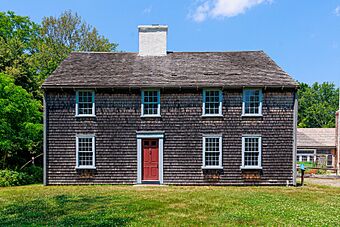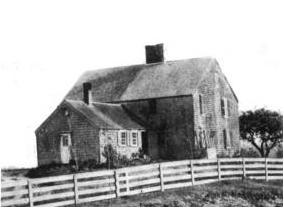John and Priscilla Alden Family Sites facts for kids
|
John and Priscilla Alden Family Sites
|
|

Alden House Historic Site in 2025
|
|
| Location | 105 Alden St., Duxbury, Massachusetts |
|---|---|
| Area | 2.4 acres (0.97 ha) |
| Built | c. 1630 (Original) c. 1700 (Current) |
| NRHP reference No. | 78000476 |
Quick facts for kids Significant dates |
|
| Added to NRHP | December 14, 1978 |
| Designated NHL | October 6, 2008 |
The John and Priscilla Alden Family Sites are two special places in Duxbury, Massachusetts. They are important because they tell the story of John Alden, one of the first settlers of the Plymouth Colony. John Alden came to America on the famous ship Mayflower. He was a very important person in the colony, holding many different jobs.
John Alden and his relationship with Priscilla Mullins became famous thanks to a poem by Henry Wadsworth Longfellow. The poem, called The Courtship of Miles Standish, made their story a well-known part of American history.
One of these sites holds the hidden remains of the house John Alden built around 1630. This site is also important for how we study history through digging, thanks to an early archaeologist named Roland W. Robbins. The town of Duxbury now owns this land.
The second site has a house that people used to think John Alden built around 1653. However, experts have found that it was likely built around 1700, probably by Alden's grandson. This house has always been owned by the Alden family. Today, a family group manages it as a museum, where visitors can learn about the past.
Contents
Alden Homestead Site: Digging Up History
The Alden Homestead Site is on a small hill overlooking the Bluefish River. This land is now owned by the town of Duxbury. The Duxbury Junior High School is mostly on this property. Wooden posts show where the old house foundation was found by Roland Wells Robbins in 1960. A bronze sign on a stone about 75 feet (23 m) away says, "Site of the John Alden House built 1627."
This land was part of a 100-acre (40 ha) area given to John Alden in 1628. It is about 750 feet (230 m) from the Alden House, which is next to the town property.
People have been interested in this site since the 1800s, when old items were found there. The first official search for historical objects happened in the 1950s. However, archaeologists did not find the house foundation then. In 1960, the Alden Kindred Foundation, which owns the Alden House, hired Roland Robbins to look into the area.
Robbins found and dug up a granite foundation, which was about 38 by 10.5 feet (11.6 m × 3.2 m) in size. He also found a deep cellar hole under the western part of the foundation. He dug inside the foundation, including the cellar. He found more than 7,000 historical items and 2,000 items from Native American times. Most of the historical items were nails and other building materials. Many cultural items showed that people stopped living at the site in the 1650s. After talking with other archaeologists and looking at old documents, Robbins believed the house was built in 1632.
New studies and a fresh look at Robbins' work by Craig Chartier suggest something different. The foundation might have been an addition to an older 20 by 20 feet (6.1 m × 6.1 m) building. This older building was likely "earthfast," meaning it was built with wooden posts set directly into the ground. This building style was common in other Plymouth Colony sites. Chartier thinks this site was John Alden's home for most of his time in Plymouth.
Alden House Historic Site: A Family Home
The Alden House Historic Site is a museum house located at 105 Alden Street in Duxbury, Massachusetts. It was once home to John and Priscilla Alden. For a long time, people believed the house was built in 1653 as John and Priscilla's second home. Some even thought the original building might have been as early as 1630.
However, in 2003, scientists used a method called dendrochronology (studying tree rings) and looked closely at the house's structure. They found that the current house was likely built around 1700. This was after John and Priscilla had passed away.
John Alden was a "cooper" (someone who makes barrels) on the Mayflower. He arrived in Plymouth Colony in 1620 and later moved to Duxbury. He was not a Pilgrim himself, but he was a very important person throughout the time of the Plymouth Colony. It's possible that parts of Alden's earlier house, which was nearby, were used to build this house.
Recognition: A National Treasure
These sites were added to the National Register of Historic Places in 1978. They were then named a National Historic Landmark on October 6, 2008. This means they are recognized as very important places in American history.
See also
- List of the oldest buildings in Massachusetts
- List of National Historic Landmarks in Massachusetts
- National Register of Historic Places listings in Plymouth County, Massachusetts
Gallery








